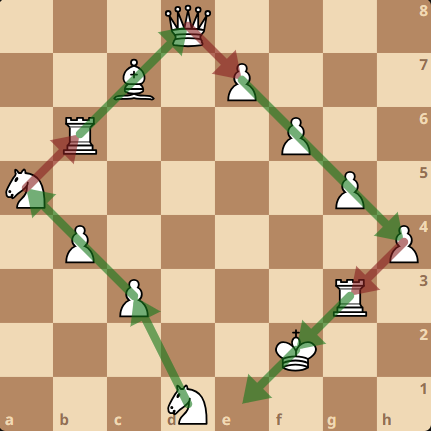Babel Chess
Babel Chess, initially called Zero Gravity Chess, is a sub-variant of Banzai Chess, where things become even crazier.
The main ideas behind this variant are:
1) to give players even more flexibility
2) to allow nasty and wild combinations
3) to invite a free and creative approach to the game
For those seeking a real challenge and for those who just want to have fun, withouth abandoning the traditional chess framework.
Rules
If you already played Banzai, than the only thing you need to know is that you can push more than 1 piece with a single move.
If you never played Banzai, don't worry, it is pretty simple. Only 5 things change compared to standard chess.
- Pieces can move to a square occupied by other friendly pieces, pushing them.
- A piece on the edge pushed diagonally can bounce inward.
- Pawns on the respective first 2 ranks can always advance 2 steps.
- Pawns can capture En Passant also on the third and sixt rank.
- Pawns pushed to Promotion can only Underpromote.
The main feature of both Banzai and Babel is the Push Rule. Everything else is more or less derived from this single addition.
This rule allows you to move any piece to a square occupied by another of your pieces by pushing it. The pushed piece is moved to an adjacent square according to the direction of the initial piece's movement. It is not possible to capture while pushing.
To see the destination square simply follow the direction of the initial piece's movement and the position of the pieces on the board.
- Each piece pushes in the same way it moves, except knights which push diagonally.
Visual rapresentation of all the different push directions + How the knights push


In the standard version of Banzai the moving piece can only push 1 piece per move, therefore the destination square of the latter must be empty. In Babel Chess instead, if the destination square of the pushed piece is occupied by another friendly piece, the push might continue, moving by one square any friendly piece along the way. Basically, the main difference is that a pushed piece can also push.


Figure 1 Example of multi-push moves with the king Figure 2 Example of multi-push moves with 3 bounces



Figure 3 Example of multi-push moves in the opening Figures 4-5 Visualization of Push and Bounce directions
The Bounce Rule, is a sub-rule of the Push Rule. In fact, only a (diagonally) pushed piece can bounce.
The bounce operates as a push, meaning the piece will move by one square, if that square is empty or occupied by other pushable pieces, but with a new trajectory.
-
The bounce direction is simply the push direction reflected towards the inside of the chessboard.
Visual rapresentation of all the different bounce directions.


Notes
As for Banzai Chess, there is no way to play Babel Chess online yet, but you can still play it with anyone over a real chessboard!
For taking track of your games you can use the standard (algebric) chess notation.
 This 'user submitted' page is a collaboration between the posting user and the Chess Variant Pages. Registered contributors to the Chess Variant Pages have the ability to post their own works, subject to review and editing by the Chess Variant Pages Editorial Staff.
This 'user submitted' page is a collaboration between the posting user and the Chess Variant Pages. Registered contributors to the Chess Variant Pages have the ability to post their own works, subject to review and editing by the Chess Variant Pages Editorial Staff.
By Vincenzo Rapisardi.
Last revised by Vincenzo Rapisardi.
Web page created: 2024-05-10. Web page last updated: 2024-05-27